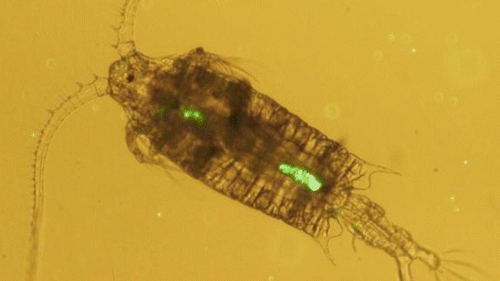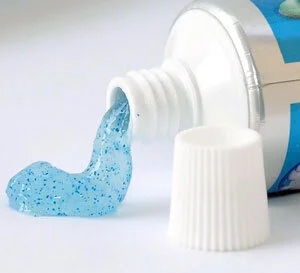Pesky plastic: The true harm of microplastics in the oceans
By Jessie Perelman, Safina Center Fellow
Plastics break down in aquatic environments and get consumed by fish, zooplankton and invertebrates. Photo: Archipelagos Institute
Pollution is evidently a major concern when talking about environmental protection in light of human development, but waste that ends up in the oceans is oftentimes overlooked. This is in part because many people do not come face-to-face with it on a daily basis, and the effects caused by contaminating the world’s waterways have not yet reverberated back to affect humans in a substantial way. This “out of sight, out of mind” mentality keeps people from truly understanding the consequences of marine pollution and heedless disposal of waste items. From solid garbage to sewage disposal to fertilizer runoff, more than 80% of waste that ends up in the ocean is generated on land, and one of the major contributors to this mess is plastic. As useful as it is, plastic is a substance that is made to last and does not biodegrade significantly. With numerous recycling and reusable product initiatives circulating today, including water bottles and grocery bag usage to name a few, it seems that strong actions are being taken to minimize the amount of plastic that end up in the environment, which will ultimately help keep it out of the oceans.
There is a certain type of plastic, however, whose damaging effects are not yet widely recognized by the public, and these are microplastics. Microplastics are particles less than five millimeters in size that deteriorate from larger plastic pieces that have entered the oceans. The issue with them has recently come into light due to the use of plastic microbeads in personal care products such as exfoliating shower gel, toothpaste, and makeup, which all wash down the drain. These plastic ingredients can comprise up to 90% of such products, and according to a 2012 survey, 4,360 tons of microbeads were used throughout all European Union countries in that year alone. In light of growing apprehension regarding ocean pollution, and considering the broad range of products from which this pollution originates, it is no shock that tiny plastic particles can accumulate to such quantities as 93-236 thousand tons floating in the oceans as predicted by a recent study in Environmental Research Letters. It is concerning, however, that this amount is 37 times greater than previous estimates because it speaks to just how much more abundant these pesky products are becoming, and how much of an impact they can realistically have on marine wildlife.
A study completed in 2015 from Environmental Science & Technology alarmingly found that eight trillion microbeads were entering aquatic environments throughout the United States every day. This troubling statistic poses the question of how such massive quantities of microplastics are impacting aquatic wildlife, a topic discussed in the recent article, “More Plastic, Fewer Oysters?” via National Geographic’s Ocean Views. The article addresses the harm that consumption of microplastics has had on crustaceans and other filter feeders, and it seems that adding microplastics to the diet of oysters proves that this can have major repercussions on a number of marine organisms. As reiterated from the study by the French Institute for the Exploitation of the Sea, “Oysters that consume microplastics eat more algae and absorb it more efficiently…[their] ability to reproduce is almost halved.” This information is eye opening, laying a platform from which to look deeper into the issue. What is the seriousness of such health implications? Filter feeding organisms are vital components of marine food webs, and their demise could mean severe threats to numerous trophic levels, and perhaps to the humans who rely on these species as a source of food.
Tiny zooplankton like this one readily ingest microplastics in marine habitats. Credit: Matthew Cole, et al., courtesy of the journal “Environmental Science & Technology.”
Another concern with these foreign particles entering the oceans is that the chemicals comprising microplastics are causing reproductive complications in oysters, which is a very important point to address. Chemical toxins such as DDT and BPA have been found to adhere to microplastic particles according to a Global Microplastics Initiative, which then “enter the food chain when ingested by aquatic life, accumulating in birds, fish, marine mammals and potentially humans.” Could there be further implications of such chemicals to the well being of this broad range of organisms? If accumulation of microplastic toxins can affect reproduction, then it is likely to affect other biological functions within various marine species. Microplastics have already been found inside the bodies of so many organisms, and if attempts to mitigate this problem are going to be successful, it is imperative to understand the full extent of damage that the products are causing.
This past December, President Obama signed a bill banning the use of microbeads in all personal care products. This act is an indication that microplastic pollution is a genuine concern to the highest levels of government and will continue to damage aquatic habitats and waterways if preventative action is not taken immediately. The bill, along with new ideas such as The Ocean Cleanup project, which proposes a method to remove 70,000 metric tons of plastic from the oceans within 10 years, are leading the elimination effort in the right direction. But targeting microplastics will be a much greater endeavor, and eradicating the trillions of tiny particles that have already entered the oceans will be the next big challenge in ocean conservation.
Microbeads are a major source of microplastic pollution and are found in everyday personal care products. Photo: UNEP’s Global Programme of Action



